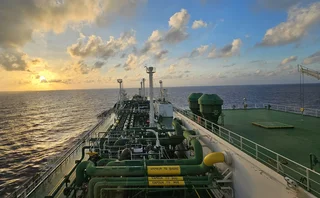Video: FCStone calls for balance in capital and margin rules
Dodd-Frank rules must balance stability and market liquidity, says global head of risk
The US Commodity Futures Trading Commission (CFTC) must find a balance in its upcoming capital and margin rules between financial stability and draining market liquidity, says Tricia Harrod, global head of risk at New York-based commodity risk management firm INTL FCStone.
Speaking in a video interview at Energy Risk Summit USA in Houston, Harrod says the company – a futures commission merchant (FCM) and provisionally registered swap dealer under the US Dodd-Frank Act – is keeping a close eye on the development of the CFTC’s proposed rules on capital and margin. The rules are one of the agency’s big pieces of unfinished business under Dodd-Frank.
“The main one that we’re watching closely is the margin and capital rules,” she says. “You’re trying to find that happy medium. You don’t want to charge more for the clients; you don’t want them to have higher fees with the margin and hurt the liquidity ... You’ve got to find that balance.”
While brokers need to have enough capital and margin to cover losses and defaults, she says it’s important the agency doesn’t go too far, “because if you set aside capital and it’s not being used ... you’re taking liquidity out of the market”.
More generally, Harrod says a wave of new regulation is the “largest risk” INTL FCStone currently faces. “Our largest risk right now is regulatory risk,” she says, pointing to the unfinished rules on capital and margin, as well as the CFTC’s proposals for federal position limits on commodity derivatives. “I’m looking forward to getting to the end of the year when we have the margin and capital rules and the position limit rules and we can finalise a lot of the things that we need to make sure we’re in compliance."
Harrod also gave an insight into INTL FCStone’s risk management process, saying the firm tends to pay less attention to measures such as value-at-risk in favour of stress testing. That approach is particularly prudent in light of recent history, she argues, pointing to sharp gyrations in the value of cocoa futures and the Swiss franc. “In today’s environment, you have commodities like cocoa, or the Swiss franc, or all these things that they said would never move more than 5% or 10%, and we’re seeing those volatilities,” she says.
Another market that has seen volatility pick up in the past year is crude oil. Having spent about two years at or above $100 a barrel (/bbl), prices for front-month Brent North Sea crude began to slide in the second half of 2014. In January, the front-month contract traded on Atlanta-based exchange Ice dipped beneath $50/bbl. By June 17, it had recovered somewhat, closing at $63.87/bbl.
Amid the dramatic moves, INTL FCStone and its clients fared well, says Harrod. “The recent fall in oil prices has gone quite well, much better than you’d expect,” she says. “The market-maker aspect of INTL FCStone, the swap dealer, saw no issues. Our clients were able to respond very well to all the margin calls and there were no deficits.”
More on Risk management
CRO interview: Shawnie McBride
NRG’s chief risk officer Shawnie McBride discusses the challenges of increasingly interconnected risks, fostering a risk culture and her most useful working habits
Increasingly interconnected risks require unified risk management
Operational risk is on the rise according to a Moody's survey, making unified risk management vital, say Sapna Amlani and Stephen Golliker
Energy Risk Europe Leaders’ Network: geopolitical risk
Energy Risk’s European Leaders’ Network had its first meeting in November to discuss the risks posed to energy firms by recent geopolitical developments
Energy Risk US Leaders’ Network: tackling volatility
Energy Risk’s inaugural US Leaders’ Network convened in Houston in October to discuss risk management challenges caused by geopolitical upheaval, policy uncertainty and volatility
LNG trading strategies set to change amid major market shifts
The global LNG market is on the brink of significant changes set to alter trading dynamics and market behaviour, say analysts
Why commodity finance is ripe for stablecoin
Digital currency brings cost efficiencies to financing, but its real benefit to commodity firms lies in making huge pools of new capital available, write Jean-Marc Bonnefous and Ronan Julien
US shutdown leaves commodity traders without key data
Commodity traders are ‘flying blind’ without Commitment of Traders reports
Energy Risk at 30: Learning from the past
Energy Risk looks back at the seminal events and developments that have shaped today’s energy markets







